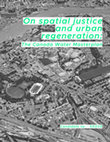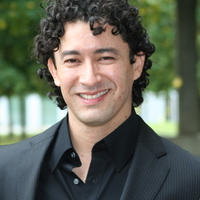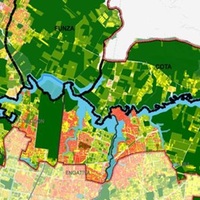Papers by María José Gonzales Zevallos

Is coexistence between urban, rural, and natural landscapes possible?
This final degree project ... more Is coexistence between urban, rural, and natural landscapes possible?
This final degree project addresses the challenge of uncontrolled urban growth in Lima, which has led to the loss of agricultural areas and negatively impacted residents’ quality of life, the urban fabric, and its relationship with the environment. The proposal introduces an “agrarian park” as a solution—a space comprising the last 77 hectares of agricultural land along the Chillón River (Comas).
The project is guided by three strategies: containment, cohesion, and connection. It aims to limit urban expansion through new boundaries with active uses that address local needs. It also seeks to promote social cohesion by engaging residents in activities within the space, catering to recreational, self-sustenance, and economic needs. Additionally, it envisions neighbourhood and metropolitan connections, ensuring integration with the wider urban context. Water becomes a central element, guiding changes in the landscape, city edges, and architectural interventions through four levels of water purification.

The report critically examines the Canada Water Masterplan, an urban regeneration project aimed a... more The report critically examines the Canada Water Masterplan, an urban regeneration project aimed at transforming the area into a mixed-use, sustainable urban centre. Framed within the concept of spatial justice, which emphasises equitable access to services and opportunities in urban environments, the report evaluates the social, economic, and spatial impacts of the project. The analysis draws on theories from Edward Soja and David Dewar, highlighting how urban design can either promote or undermine social equity, with particular concerns around gentrification, affordability, and liveability.
The Masterplan proposes the development of 3,000 homes, commercial spaces, public areas, and sustainable infrastructure. However, local residents have raised concerns regarding potential displacement, rising housing costs, and the prioritisation of wealthier newcomers. Legal actions and public opposition reflect fears that the project may worsen social inequality rather than provide inclusive benefits for the community.
The work conducts a comparative analysis between the current state of Canada Water and the proposed development, using spatial justice indicators such as accessibility, affordability, and public space quality. While the Masterplan presents opportunities for improved infrastructure, job creation, and better urban connectivity, it also poses risks of gentrification and exclusion of lower-income residents.
The analysis advocates for integrating affordable housing and supporting local businesses to prevent the area from becoming an exclusive space catering only to a privileged few, emphasising that urban regeneration should serve both the existing community and future growth.
Collisions and Trajectories: Creative Occupations as Manifestation of Throwntogetherness, 2024
This work explores housing movements in São Paulo through Doreen Massey’s concept of "throwntoget... more This work explores housing movements in São Paulo through Doreen Massey’s concept of "throwntogetherness." Focusing on Ocupação 9 de Julho and Ocupação Lélia Gonzalez, the study examines how diverse trajectories collide, fostering creative practices within these communities. Key findings reveal how these practices contribute to the visibility, legitimisation, and protection of the movements against criminalisation. The report suggests interventions to enhance recognition and integration of these struggles into São Paulo’s urban landscape, including opening a second entrance at Ocupação 9 de Julho and creating a "recipe book of trajectories" to share community's stories.









Uploads
Papers by María José Gonzales Zevallos
This final degree project addresses the challenge of uncontrolled urban growth in Lima, which has led to the loss of agricultural areas and negatively impacted residents’ quality of life, the urban fabric, and its relationship with the environment. The proposal introduces an “agrarian park” as a solution—a space comprising the last 77 hectares of agricultural land along the Chillón River (Comas).
The project is guided by three strategies: containment, cohesion, and connection. It aims to limit urban expansion through new boundaries with active uses that address local needs. It also seeks to promote social cohesion by engaging residents in activities within the space, catering to recreational, self-sustenance, and economic needs. Additionally, it envisions neighbourhood and metropolitan connections, ensuring integration with the wider urban context. Water becomes a central element, guiding changes in the landscape, city edges, and architectural interventions through four levels of water purification.
The Masterplan proposes the development of 3,000 homes, commercial spaces, public areas, and sustainable infrastructure. However, local residents have raised concerns regarding potential displacement, rising housing costs, and the prioritisation of wealthier newcomers. Legal actions and public opposition reflect fears that the project may worsen social inequality rather than provide inclusive benefits for the community.
The work conducts a comparative analysis between the current state of Canada Water and the proposed development, using spatial justice indicators such as accessibility, affordability, and public space quality. While the Masterplan presents opportunities for improved infrastructure, job creation, and better urban connectivity, it also poses risks of gentrification and exclusion of lower-income residents.
The analysis advocates for integrating affordable housing and supporting local businesses to prevent the area from becoming an exclusive space catering only to a privileged few, emphasising that urban regeneration should serve both the existing community and future growth.
This final degree project addresses the challenge of uncontrolled urban growth in Lima, which has led to the loss of agricultural areas and negatively impacted residents’ quality of life, the urban fabric, and its relationship with the environment. The proposal introduces an “agrarian park” as a solution—a space comprising the last 77 hectares of agricultural land along the Chillón River (Comas).
The project is guided by three strategies: containment, cohesion, and connection. It aims to limit urban expansion through new boundaries with active uses that address local needs. It also seeks to promote social cohesion by engaging residents in activities within the space, catering to recreational, self-sustenance, and economic needs. Additionally, it envisions neighbourhood and metropolitan connections, ensuring integration with the wider urban context. Water becomes a central element, guiding changes in the landscape, city edges, and architectural interventions through four levels of water purification.
The Masterplan proposes the development of 3,000 homes, commercial spaces, public areas, and sustainable infrastructure. However, local residents have raised concerns regarding potential displacement, rising housing costs, and the prioritisation of wealthier newcomers. Legal actions and public opposition reflect fears that the project may worsen social inequality rather than provide inclusive benefits for the community.
The work conducts a comparative analysis between the current state of Canada Water and the proposed development, using spatial justice indicators such as accessibility, affordability, and public space quality. While the Masterplan presents opportunities for improved infrastructure, job creation, and better urban connectivity, it also poses risks of gentrification and exclusion of lower-income residents.
The analysis advocates for integrating affordable housing and supporting local businesses to prevent the area from becoming an exclusive space catering only to a privileged few, emphasising that urban regeneration should serve both the existing community and future growth.